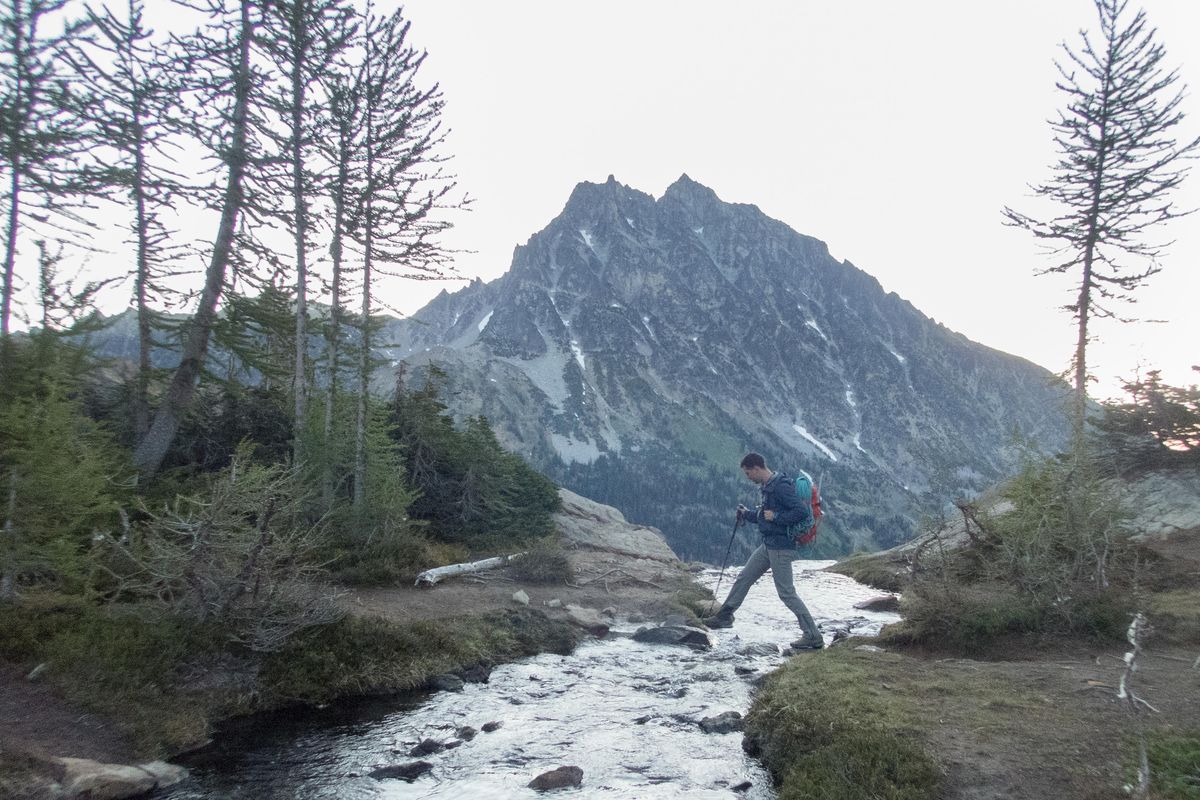For hikers skunked on Enchantment permits, Lake Ingalls area offers gorgeous alternative

Lost out, yet again, on a highly coveted and competitive overnight camping permit to the Enchantments?
The Lake Ingalls area offers a more-than-worthy alternative with little fuss.
But the very things that make it a spectacular and accessible destination could be the seeds of its undoing.
In July, I went to Lake Ingalls while climbing Mount Stuart. While the lake was not the main objective of our trip, it could have been.
The area is easily accessed, physically and logistically. It’s about a 5-mile hike from the trailhead to the pass. As mentioned above, no overnight camping permit is required.
The Enchantments and the Lake Ingalls area are part of the Alpine Lakes Wilderness.
My climbing partner, Will Holmquist, and I headed up the trail on July 4 around 2 p.m.
After hiking for about a mile through pines, we stepped out into a more rugged and raw alpine environment. At first we passed many groups and individuals hiking down. But the higher we got, the fewer people we saw. Once we gained Ingalls Pass, from which we had spectacular and sobering views of Mount Stuart and Ingalls Peaks, the crowds thinned.
As far as we could tell, we were the only ones who camped that evening.
From Ingalls Pass, there are two ways to reach the lake, which is not visible from the pass. The right fork drops into the basin and is the more direct route. It presents a greater physical and route-finding challenge.
We went left, following a meandering and clearly marked trail. About one-half from the pass we came across some marked camping sites.
Camping is prohibited at the lake. Because of the high volume of people who visit, only certain areas may be camped at. Look for signs and obey them. Additionally, the entire area is designated wilderness. Dogs and campfires are prohibited.
The remainder of our evening slipped into setting up camp, filtering water and preparing for the morning’s climb.
As the temperature dropped and the sun’s rays grew long, the beauty of the place took on an ethereal and distinctly nonhuman mood.
Sitting on a slab of white granite, I wondered how a place like this, so close to the Enchantments and ever-expanding Seattle, has no overnight permit requirements.
The truth is, it nearly did.
In 1993 an environmental impact study was conducted for the Alpine Lakes Wilderness area. The EIS included the Ingalls Lake area.
Following the EIS, the Enchantments and the Ingalls Lake area were both approved to become part of the overnight camping permit system, said Carly Reed the Okanogan-Wenatchee National Forest wilderness manager.
But an issue arose.
Lake Ingalls is in the Wenatchee Ranger district. The only easy access point is the Lake Ingalls trailhead, a 2-hour drive from the Wenatchee Ranger station. At that time, there was no Cle Elum ranger station.
Because this was in the lawless and wild days of no internet, permits had to be submitted in person or via mail.
In short, Reed said, overnight permits for the Lake Ingalls area were dropped because of the logistics.
“Unfortunately, we had an opportunity and didn’t take it,” she said.
Why that was unfortunate wouldn’t be visible to me until the following day.
We left our tent at 5 a.m. and started approaching the west ridge of Stuart. As we hiked, I noticed signs of overuse and bad use.
Toilet paper half buried, or fluttering in trees, a stinky prayer flag commemorating an act of nature. Snack food wrappers. Camping sites on sensitive alpine meadows.
“We have seen skyrocketing day and overnight use,” Reed said.
In 2014, Reed counted 400 people on the trail during the fall larch season.
“It was insane,” she said. “We had never seen numbers like that before.”
Even during the climb, we saw signs of heavy use. We passed numerous loops of webbing, slings and cord, commonly called “tat.”
Or rudimentary camp sites made by piling rocks to create a wind break.
These things may seem small and inconsequential. On a climb, especially, it’s sometimes necessary to leave gear behind or sleep in an unexpected spot.
With hundreds tramping up a trail and numerous parties climbing, however, Stuart the little things add up.
“I just wish people would understand the rules and regulations before they hit the trail,” Reed said.
That’s her focus: improved signage and education. The forest service has volunteer rangers who spend their summers talking to people about the rules of the land.
But in addition to knowing the rules, there is something we recreationists can do.
Get off the beaten path.
“You don’t have to go the place that your 15 friends put on Instagram,” Reed said. “More and more, you see people not researching or coming up with their own travel routes or experiences.”
In the Alpine Lakes Wilderness area there are hot spots, like Ingalls Lake and Colchuck Lake. Everyone goes. Lines get long. Nature is abused.
“Each district has their own little problem areas that are these beautiful picturesque locations but are just loved to death, as we like to say,” she said.
So if you’re longing for a taste of the Enchantments but can’t, or haven’t, received an overnight permit, consider Lake Ingalls. Visit. Follow the rules. Be respectful.
And then go somewhere else.